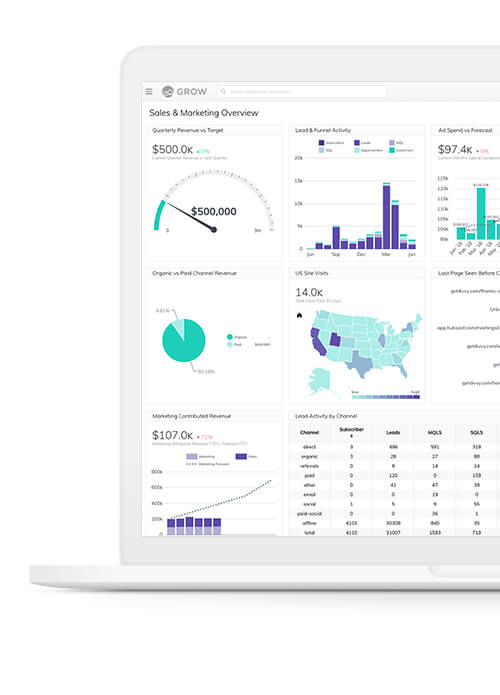You sit down across from your CMO, shake hands, and pull up a report of your marketing campaigns. They nod, stone-faced, and ask you if you can optimize things even further. You smile and tell them of course. They leave, and then you hit the books.
The most tedious part of optimization is deciphering enormous quantities of data to get the answers you really need. They’re there, but getting at them is HUGELY time-consuming.
It’d be great if you could optimize the data-crunching process, right?
Here are three tactics you can use to speed up your data dive and find opportunities to grow your marketing strategy.
Keep your eye on the KPI
As you dig into your data, use your marketing KPIs as your guiding stars to help you navigate. Rather than getting lost or overwhelmed by the quantity of your data, your KPIs can keep you focused on finding the answers to specific questions.
Rather than getting lost or overwhelmed by the quantity of your data, your KPIs can keep you focused on finding the answers to specific questions.
For example, let’s say that you’re the CRO and you’re trying to find ways to optimize marketing and sales.
Marketing has hit its goals for delivering marketing-qualified leads (MQLs) and converting them into SQLs for sales (your identified KPI for marketing), but the sales team is lagging in hitting its numbers (your identified KPI for sales).
Superficially, you might think that the sales team is just falling behind on their end. But after some digging you come to realize that there’s a disconnect between the two sets of goals, and the company needs to redefine middle-of-the-funnel goals (and choose better sales KPIs to go along with them).

Manage your metrics
Metrics are what inform your KPIs (in the list above we reference bounce rate, conversion rate—these are metrics). The more on top of your metrics you are, generally the less time you have to spend digging into your data.
The more on top of your metrics you are, generally the less time you have to spend digging into your data.
Most of us will check several different systems to access different metrics (inbound leads are stored in Salesforce, website user behavior is in Google Analytics). The best thing you can do with your metrics, aside from being aware of them, is to centralize them in a way that allows you to compare data side by side. There are a few different ways you can manage your metrics:
- If you have a small number of reporting systems, you can pull in data into a single spreadsheet. Google Sheets has add-ons with some systems, like with Google Analytics, that will even automatically pull in data for you.
- If you have a small number of reporting systems and you want to visualize your data in a dashboard, you can use a simple dashboarding tool to add charts and manage data tables. Google Data Studio is free and very easy to use.
- If you have a larger number of reporting systems and you want to create new metrics by combining data from different sources, you’re going to need a more advanced tool. End-to-end BI systems (like us!) can help you manipulate data from different sources.

Whatever method you choose, the best way to stay on top of your metrics is by:
- Centralizing your data from your various reporting systems (your ERP, CRM, website, analytics, etc). Being able to see that data side by side and let it inform each other is invaluable.
- Visualizing your data. There’s a big difference between seeing numbers on a spreadsheet and seeing them in a chart that can give you the full impact of your status.
- Sharing your data. Whether it’s with your CMO or with other members of your team, getting everyone on the same page will go a long way.
Know your data history
Single data points are rarely useful. What’s crucial is being able to analyze progress over a period of time. Month-over-month and year-over-year are the two most common time frames and both have a place in optimization. Both are long enough to show the arc of movement for each measured KPI but not so long as to be unhelpful in spotting current trends.
Single data points are rarely useful. What’s crucial is being able to analyze progress over a period of time.
By making sure your tracking data over a significant period of time, you can also account for seasonal trends and spikes related to specific events in your analysis of long-term performance.
Historical data helps you identify two ranges for your marketing strategy’s goals:
- What sort of future performance you can realistically expect, based on past performance data.
- What lies just beyond that realistic forecast—i.e., the stretch goals that will challenge you but are still possible to attain.
If conversion rates on a specific page routinely increase by 5% each month, then 5% is a reasonable practical goal informed by historical data. To challenge yourself, set a stretch goal of 7 to 10%.
Navigating your data to get at answers
Of course, you already know that these metrics and numbers, while deeply helpful and transmitting lots of actionable information, aren’t the point in and of themselves. Rather, they’re there to show you what you need to work on most urgently, and where your priorities should lie.
The key is always to translate your data into actionable items.
Are you ready to take your agency’s optimization programs to the next level and dazzle your clients? Get in touch with us now to request a demo and find out how Grow can help your clients with simple business intelligence for powerful, optimized marketing.

.png)



